instrument panel PEUGEOT BOXER 2015 Owners Manual
[x] Cancel search | Manufacturer: PEUGEOT, Model Year: 2015, Model line: BOXER, Model: PEUGEOT BOXER 2015Pages: 276, PDF Size: 8.99 MB
Page 4 of 276
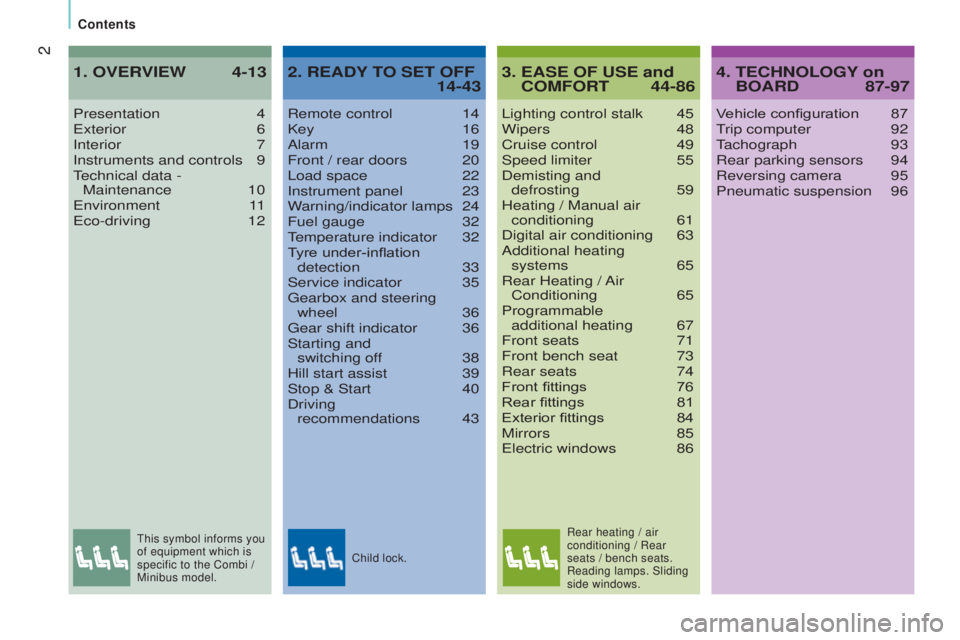
2
contents
3. EASE oF uSE and coMFort 44-86
Lighting control stalk 45
Wipers 48
Cruise control 49
Speed limiter 55
Demisting and defrosting
59
Heating / Manual air conditioning
61
Digital air conditioning 63
Additional heating systems
65
Rear Heating / Air Conditioning
65
Programmable additional heating
67
Front seats 71
Front bench seat 73
Rear seats 74
Front fittings 76
Rear fittings 81
Exterior fittings 84
Mirrors 85electric windows 86
Presentation
4exterior 6
Interior 7
Instruments and controls 9technical data - Maintenance 10environment 1
1
eco-driving 12
1. oVErVIEW 4-13 4. tEcHnoLoGY on
BoArd 87-97
Vehicle configuration 87trip computer 92tachograph 93
Rear parking sensors 94
Reversing camera 95
Pneumatic suspension 96
2. rEAdY to SEt oFF 14-43
Remote control 14
Key 16
Alarm 19
Front / rear doors 20
Load space 22
Instrument panel 23
Warning/indicator lamps 24
Fuel gauge 32temperature indicator 32
Tyre under-inflation detection
33
Service indicator 35gearbox and steering
wheel 36gear shift indicator 36
Starting and switching of
f
38
Hill start assist 39
Stop & Start 40
Driving recommendations
43
this symbol informs you
of equipment which is
specific to the Combi
/
Minibus model. Child lock.Rear heating / air
conditioning / Rear
seats / bench seats.
Reading lamps. Sliding
side windows.
Page 7 of 276
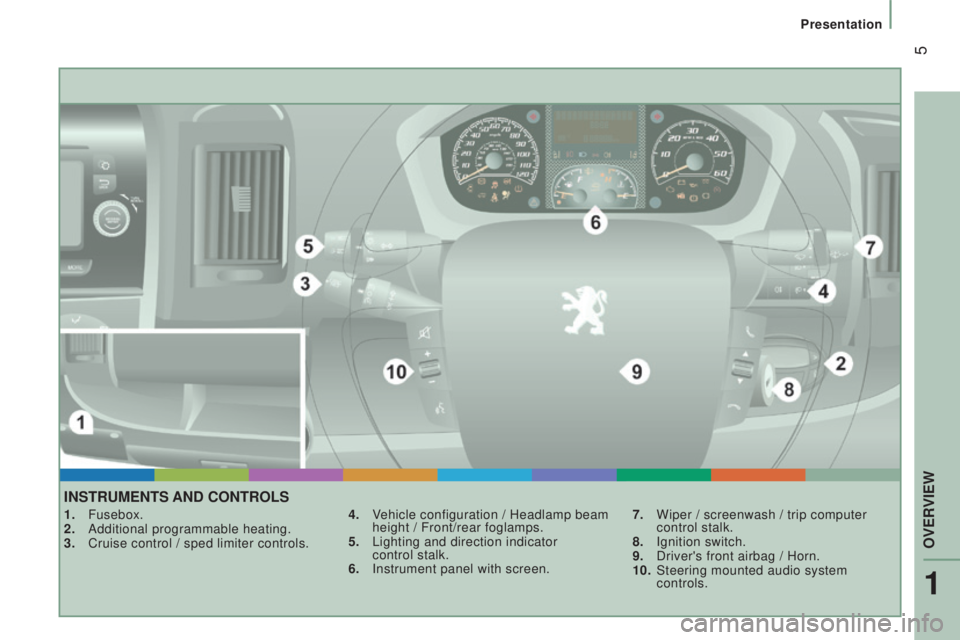
5
InStruMEntS And controLS
1. Fusebox.
2. Additional programmable heating.
3. Cruise control / sped limiter controls. 4.
Vehicle configuration / Headlamp beam
height / Front/rear foglamps.
5.
Lighting and direction indicator
control stalk.
6. Instrument panel with screen. 7.
Wiper / screenwash / trip computer
control stalk.
8.
Ignition switch.
9. Driver's front airbag / Horn.
10. Steering mounted audio system
controls.
1
OVeRVIeW
Presentation
Page 11 of 276
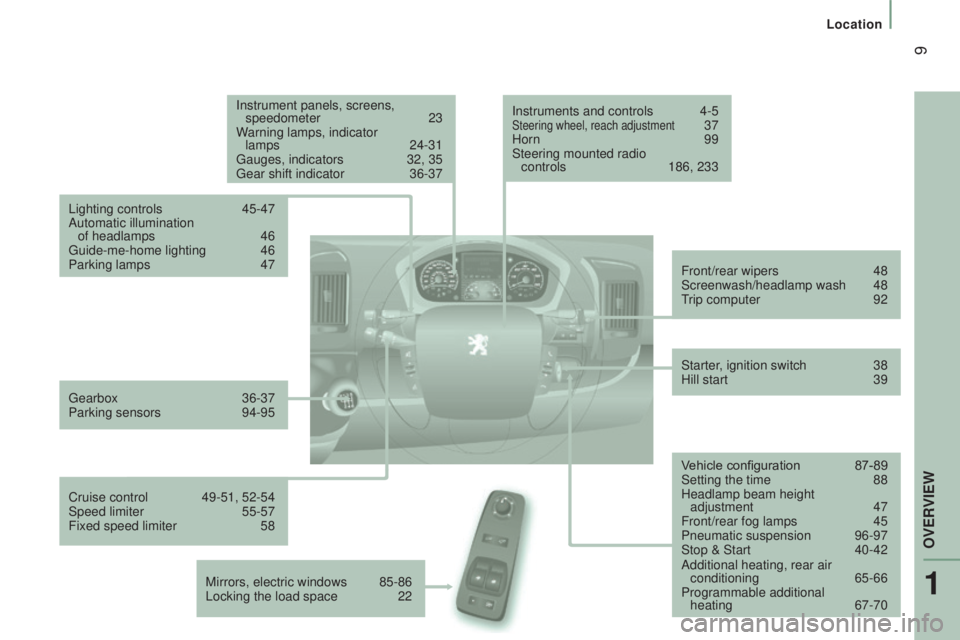
9
Instrument panels, screens, speedometer 23
Warning lamps, indicator
lamps
24-31gauges, indicators 32, 35gear shift indicator 36-37
Lighting controls
45-47
Automatic illumination of headlamps
46guide-me-home lighting 46
Parking lamps 47
Vehicle configuration
87-89
Setting the time 88
Headlamp beam height adjustment
47
Front/rear fog lamps 45
Pneumatic suspension 96-97
Stop & Start 40-42
Front/rear wipers
48
Screenwash/headlamp wash 48trip computer 92
Starter, ignition switch
38
Hill start 39
Cruise control
49-51, 52-54
Speed limiter 55-57
Fixed speed limiter 58 Instruments and controls
4-5Steering wheel, reach adjustment 37
Horn 99
Steering mounted radio controls
186, 233
Mirrors, electric windows
85-86
Locking the load space 22 Additional heating, rear air
conditioning
65-66
Programmable additional heating
67-70
gearbox 36-37
Parking sensors 94-95
1
OVeRVIeW
Location
Page 14 of 276
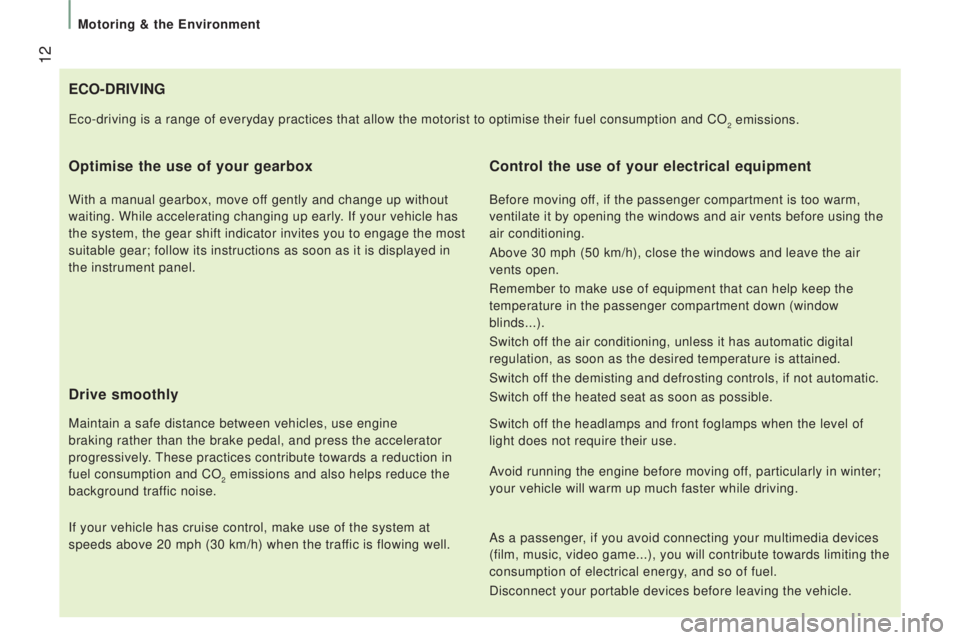
12
Eco-drIVInG
o
ptimise the use of your gearbox
With a manual gearbox, move off gently and change up without
waiting. While accelerating changing up early. If your vehicle has
the system, the gear shift indicator invites you to engage the most
suitable gear; follow its instructions as soon as it is displayed in
the instrument panel.
drive smoothly
Maintain a safe distance between vehicles, use engine
braking rather than the brake pedal, and press the accelerator
progressively.
these practices contribute towards a reduction in
fuel consumption and CO
2 emissions and also helps reduce the
background traffic noise.
If your vehicle has cruise control, make use of the system at
speeds above 20 mph (30 km/h) when the traffic is flowing well.
control the use of your electrical equipment
Before moving off, if the passenger compartment is too warm,
ventilate it by opening the windows and air vents before using the
air conditioning.
Above 30 mph (50 km/h), close the windows and leave the air
vents open.
Remember to make use of equipment that can help keep the
temperature in the passenger compartment down (window
blinds...).
Switch off the air conditioning, unless it has automatic digital
regulation, as soon as the desired temperature is attained.
Switch off the demisting and defrosting controls, if not automatic.
Switch off the heated seat as soon as possible.
Switch off the headlamps and front foglamps when the level of
light does not require their use.
eco-driving is a range of everyday practices that allow the motorist to o\
ptimise their fuel consumption and CO2 emissions.
Avoid running the engine before moving off, particularly in winter;
your vehicle will warm up much faster while driving.
As a passenger, if you avoid connecting your multimedia devices
(film, music, video game...), you will contribute towards limiting the\
consumption of electrical energy, and so of fuel.
Disconnect your portable devices before leaving the vehicle.
Motoring & the environment
Page 25 of 276
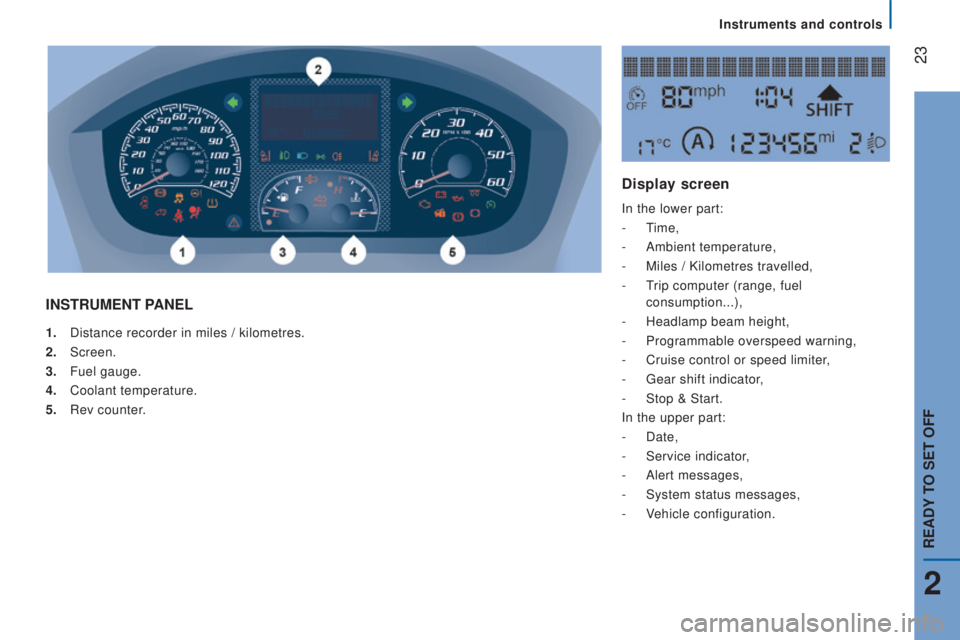
23
1. Distance recorder in miles / kilometres.
2.
Screen.
3.
Fuel gauge.
4.
Coolant temperature.
5.
Rev counter.
InStruMEnt PAnEL d
isplay screen
In the lower part:
-
time,
-
Ambient temperature,
-
Miles / Kilometres travelled,
-
t
rip computer (range, fuel
consumption...),
-
Headlamp beam height,
-
Programmable overspeed warning,
-
Cruise control or speed limiter,
-
g
ear shift indicator
,
-
Stop & Start.
In the upper part:
-
Date,
-
Service indicator,
-
Alert messages,
-
System status messages,
-
Vehicle configuration.
2
rEAdY to SEt oFF
Instruments and controls
Page 31 of 276
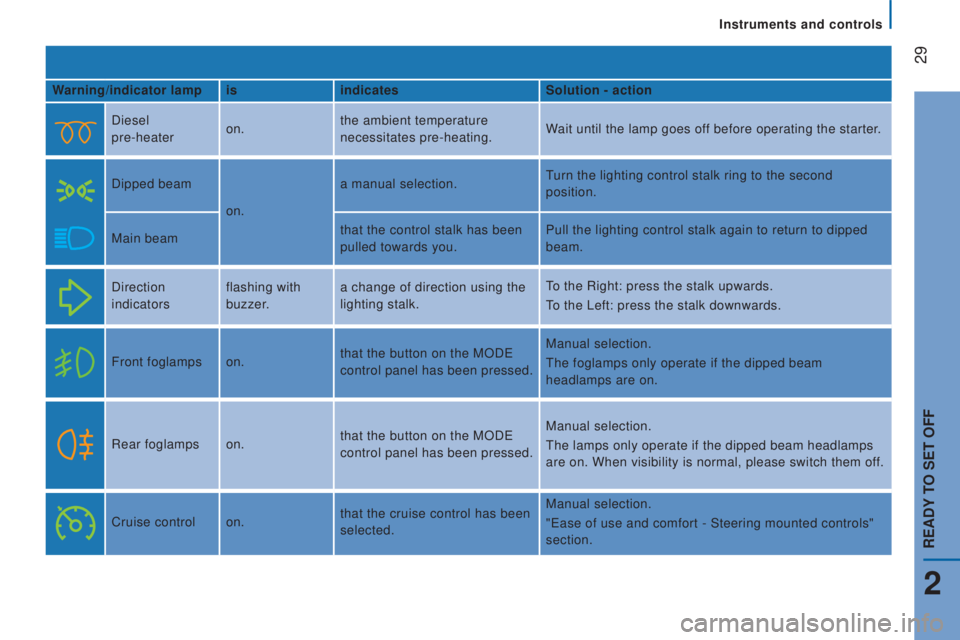
29
Warning/indicator lampisindicates Solution - action
Diesel
pre-heater on.the ambient temperature
necessitates pre-heating. Wait until the lamp goes off before operating the starter.
Dipped beam on.a manual selection.
turn the lighting control stalk ring to the second
position.
Main beam that the control stalk has been
pulled towards you. Pull the lighting control stalk again to return to dipped
beam.
Direction
indicators flashing with
buzzer.a change of direction using the
lighting stalk.
to the Right: press the stalk upwards.
to the Left: press the stalk downwards.
Front foglamps on.that the button on the MOD
e
control panel has been pressed. Manual selection.the foglamps only operate if the dipped beam
headlamps are on.
Rear foglamps on.that the button on the MOD
e
control panel has been pressed. Manual selection. the lamps only operate if the dipped beam headlamps
are on. When visibility is normal, please switch them off.
Cruise control on.that the cruise control has been
selected. Manual selection.
"
ease of use and comfort - Steering mounted controls"
section.
2
rEAdY to SEt oFF
Instruments and controls
Page 32 of 276
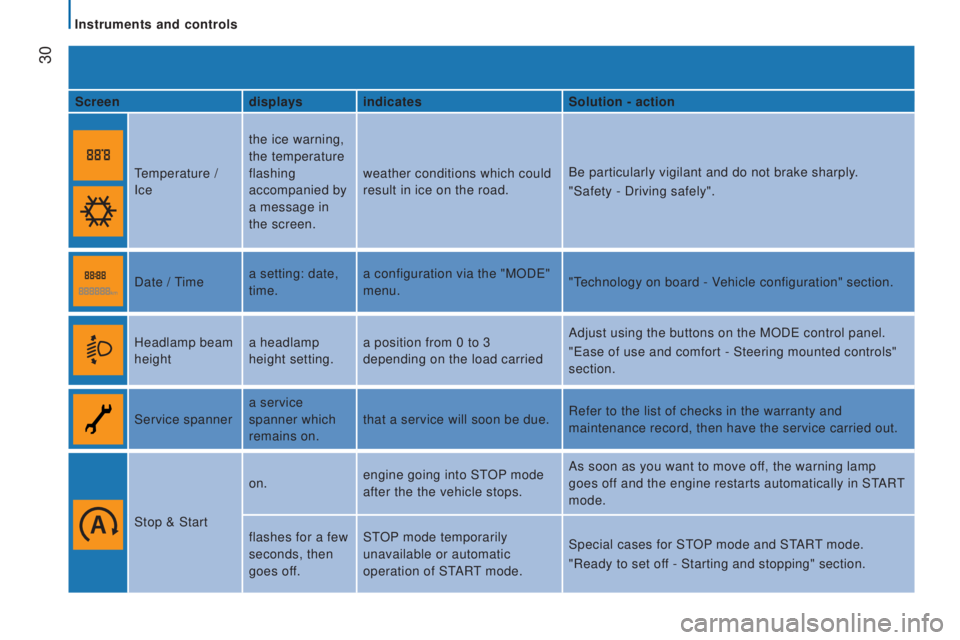
30
Screendisplays indicates Solution - action
temperature /
Ice the ice warning,
the temperature
flashing
accompanied by
a message in
the screen. weather conditions which could
result in ice on the road.
Be particularly vigilant and do not brake sharply.
"Safety - Driving safely".
Date /
time a setting: date,
time. a configuration via the "MODe"
menu. "
technology on board - V
ehicle configuration" section.
Headlamp beam
height a headlamp
height setting.a position from 0 to 3
depending on the load carried Adjust using the buttons on the MOD
e control panel.
"
ease of use and comfort - Steering mounted controls"
section.
Service spanner a service
spanner which
remains on.that a service will soon be due.
Refer to the list of checks in the warranty and
maintenance record, then have the service carried out.
Stop & Start on.
engine going into S
tOP mode
after the the vehicle stops. As soon as you want to move off, the warning lamp
goes off and the engine restarts automatically in S
tARt
mode.
flashes for a few
seconds, then
goes off. S
tOP mode temporarily
unavailable or automatic
operation of S
tARt mode. Special cases for S
tOP mode and StARt mode.
"Ready to set off
- Starting and stopping" section.
Instruments and controls
Page 35 of 276

33EMISSIonS controLS
eOBD (european On Board Diagnosis)
is a diagnostics system which complies
with, among others, the standards on the
authorised emissions of:
-
CO (carbon monoxide),
-
HC (unburnt hydrocarbons),
-
NOx (nitrous oxides) or particles,
detected by oxygen sensors placed
upstream and downstream of the
catalytic converters.
tYrE undEr-InFLAtIon dEtEctIon
System which automatically checks the
pressures of the tyres while driving.
the tyre under-inflation detection
system is an aid to driving which does
not replace the need for vigilance on
the part of the driver.
this system does not avoid the need
to check the tyre pressures regularly
(including the spare wheel) and before a
long journey.
Driving with under-inflated tyres increases
fuel consumption.
the system continuously monitors the
pressures of the four tyres, as soon as the
vehicle is moving.
A pressure sensor is located in the valve of
each tyre.
the system triggers an alert if a drop in
pressure is detected in one or more tyres.
the tyre pressures must be checked
when the tyres cold (vehicle stopped
for 1 hour or after driving for less then
6 miles (10 km) at moderate speed).
Otherwise, add 0.3 bar to the values
indicated on the label.
the tyre pressures for your vehicle can be
found on the tyre pressure label.the driver is warned of any
malfunction of this emission
control system by the illumination
of this specific warning lamp in
the instrument panel.
there is a risk of damage to the catalytic
converter. Have it checked by a P
eugeOt
dealer or a qualified workshop.
to locate it, refer to the "technical
data
- Identification markings" section.
Driving with under-inflated tyres
adversely affects road holding, extends
braking distances and causes premature
tyre wear, particularly under arduous
conditions (vehicle loaded, high speed, long
journey).
2
rEAdY to SEt oFF
Instruments and controls
Page 37 of 276
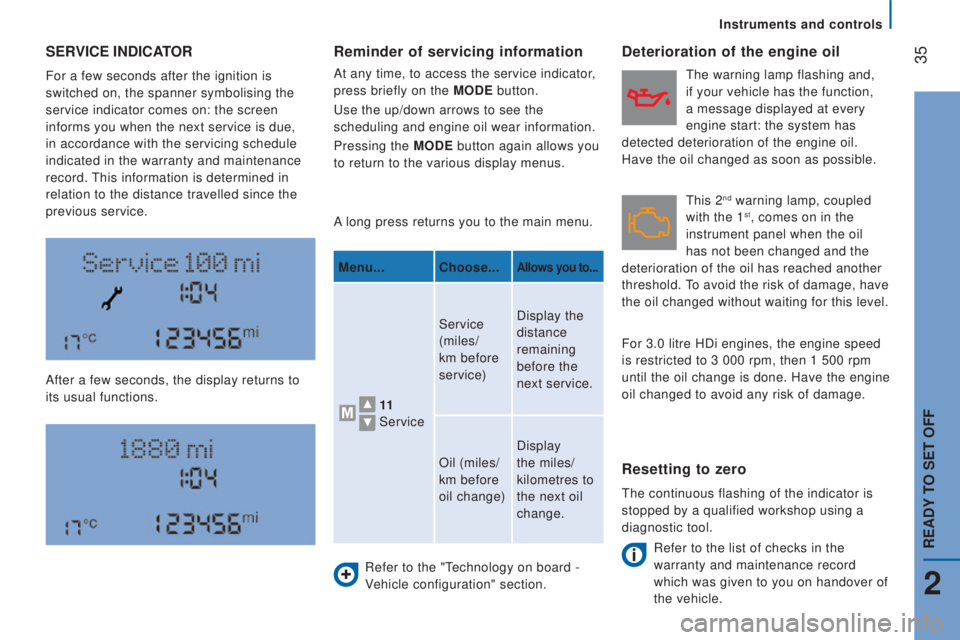
35SErVIcE IndIcAtor
For a few seconds after the ignition is
switched on, the spanner symbolising the
service indicator comes on: the screen
informs you when the next service is due,
in accordance with the servicing schedule
indicated in the warranty and maintenance
record.
this information is determined in
relation to the distance travelled since the
previous service.
After a few seconds, the display returns to
its usual functions. A long press returns you to the main menu.
Refer to the "
technology on board -
V
ehicle configuration" section.
deterioration of the engine oil
Refer to the list of checks in the
warranty and maintenance record
which was given to you on handover of
the vehicle.
reminder of servicing information
At any time, to access the service indicator,
press briefly on the M
odE
button.
use the up/down arrows to see the
scheduling and engine oil wear information.
Pressing the M
odE
button again allows you
to return to the various display menus.
Menu...
choose...Allows you to...
11
Service Service
(miles/
km before
service)
Display the
distance
remaining
before the
next service.
Oil (miles/
km before
oil change) Display
the miles/
kilometres to
the next oil
change.
resetting to zero
the continuous flashing of the indicator is
stopped by a qualified workshop using a
diagnostic tool.
this 2nd warning lamp, coupled
with the 1st, comes on in the
instrument panel when the oil
has not been changed and the
deterioration of the oil has reached another
threshold.
to avoid the risk of damage, have
the oil changed without waiting for this level.
the warning lamp flashing and,
if your vehicle has the function,
a message displayed at every
engine start: the system has
detected deterioration of the engine oil.
Have the oil changed as soon as possible.
For 3.0 litre HDi engines, the engine speed
is restricted to 3 000 rpm, then 1 500 rpm
until the oil change is done. Have the engine
oil changed to avoid any risk of damage.
2
rEAdY to SEt oFF
Instruments and controls
Page 39 of 276
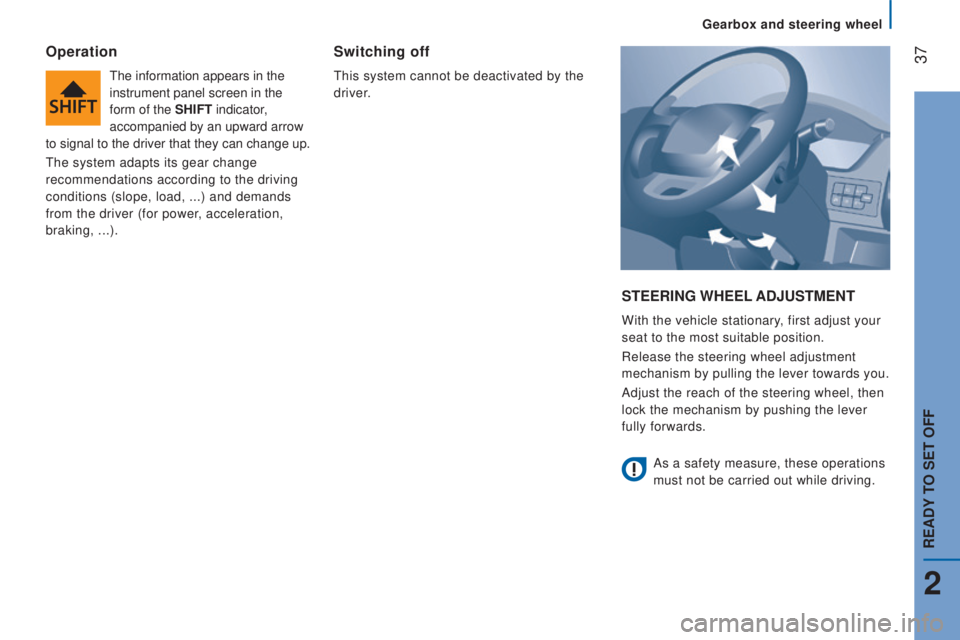
37
StEErInG WHEEL AdjuStMEnt
With the vehicle stationary, first adjust your
seat to the most suitable position.
Release the steering wheel adjustment
mechanism by pulling the lever towards you.
Adjust the reach of the steering wheel, then
lock the mechanism by pushing the lever
fully forwards.
operation
the information appears in the
instrument panel screen in the
form of the SHIF
t indicator
,
accompanied by an upward arrow
to signal to the driver that they can change up.
the system adapts its gear change
recommendations according to the driving
conditions (slope, load,
...) and demands
from the driver (for power, acceleration,
braking,
...).
Switching off
this system cannot be deactivated by the
driver.
As a safety measure, these operations
must not be carried out while driving.
2
rEAdY to SEt oFF
Gearbox and steering wheel